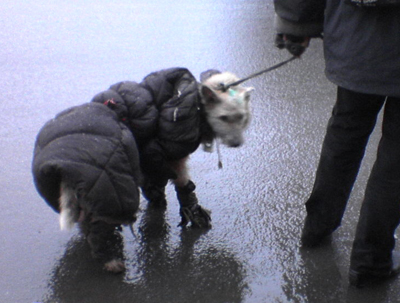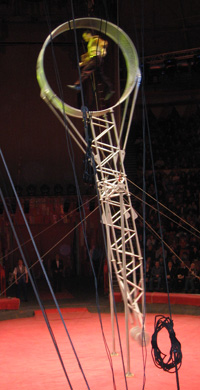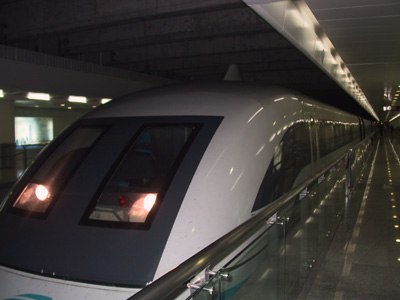Extreme meteorology

Sounds so evil. Here’s a bit of background.
FYI, the snow that is coming down is perfectly spherical. Like small hail but with the consistency of snow rather than ice.
Project wisdom from the old NASA
“If a major project is truly innovative, you cannot possibly know its exact cost and its exact schedule at the beginning. And if in fact you do know the exact cost and the exact schedule, chances are that the technology is obsolete.”
— Joseph G. Gavin, Jr., discussing the design of the lunar module* that landed NASA astronauts on the moon.
Yeah, boss. That’s why we’re late and over budget. You don’t want to be obsolete, do you?
[*] The upper half of which is called, ahem, an ascent stage. We’re all about inspirations to innovation around here.
Via SvN.
Питер 2.0
I’ve been back in St. Petersburg, Russia this week, my first visit in seven years. Much has changed, nearly all for the better.
The flight over on Lufthansa was pleasant as the snowstorm in Chicago kept most of the passengers at home. Lufthansa has recently overhauled its seats, providing in-seat power without needing any special adapters. The plug universally accepts nearly all global standard plugs. Why can’t more airlines do without the funky connector, I ask? There’s even an in-seat Ethernet port which briefly got my hopes up, but, no, the Boeing Connexion service remains shut-off. You know, it’s not like they de-orbited all the satellites. Why won’t some enterprising soul purchase them and reinstate in-flight connectivity? Please?
St. Petersburg is bustling. In 2003 the city celebrated its 300th anniversary and clearly it got spruced up for the event. The colorful, stuccoed facades of nearly all city buildings, gorgeous even back in the doldrums of the 90’s, are a vibrant pastel confection that contrasts wonderfully with the permagray of the sky and frozen canals. The uptick in the economy is visible nearly everywhere.
I stayed at a relatively new hotel, the Novotel, just off the arterial Nevsky Prospekt. It was adequate, if quaintly backward in its attempt to be a modern western business hotel. Internet connectivity was purchased by the byte, about a rouble per MB. I had no idea what to purchase, though I quickly learned that one eats up 100MB (the default purchase) without even thinking. I actually complained about it, thinking there’s no way I used 100MB over an evening of e-mail checking and web surfing. And yet, I’ve probably purchased close to 3/4 GB of throughput since I’ve been here. (And they raised prices 50% in the middle of my stay!) The hotel gym was pathetic: two flimsy bikes, one treadmill with a tread that slipped dangerously, an elliptical (broken), and two weight machines that looked like Ivan Drago castoffs from the 1980’s. Old-style Russian hotel amenities are still available, of course: prostitutes prowl the lobby bar late into the night offering “company” should you so desire.
Speaking of love for sale, I arrived on Valentine’s Day. This Hallmark holiday seems to have ridden the globalization wave nicely. My colleague and I could find no place to eat due to holiday “specials” at nearly every restaurant. We were actually waved off from a few restaurants before even getting to the host. But still, there’s an abundance of new places to eat. (And not a Starbucks in sight. My colleague drinks decaf coffee and was repeatedly stymied.) Fewer restaurants exhibit the once-standard pole-dancing entertainment, also a plus. No really, it is not so easy to dine with a topless waif sliding up and down a pole to throbbing Russopop. But, replacing vice-for-vice, nearly every restaurant we went to featured hookah pipes. (There’s no such thing as a non-smoking section in practice.) Shisha is amazingly popular here. Not only can you order dozens of flavored tobaccos, but you get options for the liquid in the chamber: water, cognac, wine, juice and even milk.
The beauty of the city is remarkable, given how ugly winter tries to make it. Slushy black snow covers every sidewalk. Dangerous ice slicks mark regular distances between building downspouts that empty right into the public walkways. And yet, the ice can be gorgeous. The Neva river is frozen solid with a small path broken through for the occasional intrepid watercraft. Each morning the path had formed a thin layer of ice on it, a scabbed laceration down the middle of the blindingly white river.
Nightclubs power the evenings here, as they do in Moscow and, according to a Russian pal, in Kiev. (He could simply not say enough about the supermodel-caliber club-life of Kiev these days.) The music seems a touch better than it did back when I first visited. It is still clogged with House-inspired Russian cheese, but I think there’s hope. We returned to an old haunt known to me only as the “Thursday club” because that’s when we’d visit it in years past. I finally asked what the real name of the club was. In passable-English my friend said “it is like a whore’s house.” Ah, I see. And all these years I just liked to drink Baltika beer there and dance. Only later did I learn that he said “like a horse’s house.” The club occupies a former stable, you see. It is right in front of the amazing Church on the Spilled Blood. Bathed in floodlights, the traditional Russian church never fails to strike awe when you stumble from the club in the wee hours.
We had a bit of free time on Saturday so we set out for the Bolshoi Puppet Theater. Everything was in Russian. We had no idea what we were watching. But it was fun to see a full-scale production done with puppets. The skill required was considerable and it was a pleasure to hear the hall full of kids chuckle. (Also a little depressing as both my colleague and I have small children at home. If you want to be instantly homesick, go sit amongst several hundred happy children in a foreign country.) The theater itself was a fire hazard waiting to happen. When the house lights went down it was absolutely pitch black. No aisle lighting, no exit signs. Children wailing. Panic could have ignited quickly. Instead, a puppet show started.
Keeping with the kid theme, we attended the St. Peterburg Circus. This circus is the oldest in Russia. It was in a stunning but dilapidated hall off the Fontanka quay and provided a theater-in-the-round for its one-ring show. I hadn’t been to a circus in many decades and yet the mixture of delight and horror as the entertainers performed death- (or least serious injury-) defying acts came right back to me, like I was eight years old. Everything was just a little bit shabby. The auditorium, the performers’ outfits, the ropes and pulleys that prevented human splattering in the ring — it all seemed a little worse for the wear. One wonders if there is any kind of circus safety review board in Russia. Most depressing of all were the animals. On the one hand it was the most diverse bestiary I’ve ever seen. To the typical circus menagerie were added porcupines, foxes, ostriches, rats, and at least two species of critters I could not identify. (Though no elephants and much to my chagrin no bears. C’mon, aren’t Russian circuses supposed to have bears?) But the big cats, horses, and dogs were all mangy and old and a few of them looked actually injured or arthritic. I’m not saying they were abused — at least not in the ring and at least insofar as being in a ring isn’t taken to be abuse — but clearly they were past their prime, just like the lion-tamer and his assistant, actually.
It is interesting to compare this mini-rebirth with the tempest of development going on in Beijing right now. St. Petersburg seems to be upgrading where Beijing is building an entirely new infrastructure. At least most of Питер was recognizable seven years on. I can hardly get my bearings in Beijing after even a few months away.
Of course, I was in town working with the fantastic Hermitage Museum. It too seems to be on the uptick with long-needed signage enhancements and halls packed with visitors. But more on this topic later.
A small photoset is available.
UPDATE: Yikes, maybe I spoke too soon. Just hours after I wrote this and left town a bomb went off across the street from my hotel, injuring six. Details here.
See also: Return to the Hermitage
Tags: russia, saintpetersburg
Imperium
In the past year I’ve visited the seats of power of three empires — the Russian, Chinese Qing, and Turkish Ottoman — that all imploded in the first 25 years of the 20th century. The imperial palaces have become public museums known today as the Hermitage, Forbidden City, and Topkapi Palace, respectively.
All are struggling to make themselves relevant to the public, but almost invariably this comes from trying to make their aesthetic opulence available to a wider audience. Little energy is expended on explaining what the palaces meant in the larger sense of empire. While amazing places to visit, these sites are mostly wunderkammer tableaux, not devices for telling the tale of conquest, governance, and power that they really represent.

The State Hermitage Museum, St. Petersburg, Russia
In all of them there exists a room with a throne carefully roped off and preserved for curious tourists to admire. Certainly it is interesting to see where heads of state sat, but it may be done for political reasons too. The throne is such a symbol of power — autocratic power — that its vacancy is comforting in a way, a reminder of a past to take some pride in, but not to repeat.

The Forbidden City, Beijing, China
It is a fine line. These cultures don’t necessarily seem to want to glorify the past form of government. The Forbidden City for instance was only saved from destruction during the Cultural Revolution by a forward-thinking Zhou Enlai. But there’s a latent pride. An acknowledgment in the empire-as-museum that theirs was a great country once and perhaps can be again.

Topkapi Palace, Istanbul, Turkey
Of course, there’s irony in the way each of these countries govern today. Two are democracies with extremely powerful heads of state, one is a communist country with imperial ambitions of a different sort. There’s more continuity between what the palaces represent and how the nations wish to be viewed globally today than you might think, methinks.
Will Capitol Hill one day be subsumed into the Smithsonian megaplex on the mall? A democratic palace-museum ode to a former mode of government?
See also: This is no country for old men and Regeneration
No, this is winter
I left town on Tuesday during an apocalyptic snowstorm for St. Petersburg, Russia — one of the few destinations from O’Hare with less clement weather than Chicago. It’s pretty damn cold.

Bungeed-comforter, makeshift paw-mittens, and some green spray-paint on the head just to make it more bizarre.
See also: Now this is winter
Austin-powered
So, I’ll be back at the fine SXSW Interactive conference/festival in Austin this year. Last year I spewed forth on convergence (skeptically). This year I get to orchestrate the spewage as I am leading a panel on virtual worlds, one of a handful on the topic in the Gaming/Screenburn category.
The panel’s called “Terraforming the Internet: When 3D Models Meet Business Models.” Saturday, March 10, 10am. Panelists are being finalized, but they’re all brilliant, articulate, laureates-in-waiting.
SXSW is simply an exceptional event and I’m happy to be a part of it. See you there?
See also: South by
In the future we will all levitate to work
I had a chance to ride the world’s only operational magnetic levitation train this week in Shanghai. It was the highlight of an otherwise awful layover. The train itself runs from Pudong airport to the terminus of one of the city subway lines (not exactly downtown Shanghai). There’s some debate about how useful this is to actual travelers, but as a way of killing time it was perfect for me. I purchased a roundtrip ticket.
Actually I purchased a VIP ticket. (They love the designation VIP here. You see it everywhere on special doors, stairways, and parking spaces.) I thought, if I’m going to ride a space-age train I am certainly going to do it in first class. In a future of jet packs, flying cars, and supertrains we’ll all be VIP’s anyway so I better get practicing. The cost difference was $2. The actual difference? Slightly nicer seats and a completely empty car cabin.

There’s a brief shudder as the train shimmies up the half-inch that the magnets levitate it above the track. Then off you go, mostly silently. Since the means of propulsion and power are embedded in the track (the magnets pull you along as well as prop you up) there’s no loud onboard engine. You accelerate quickly. Not unlike an airplane takeoff without the din. Just a few minutes in you’re moving at 430 km/h (270 mph) and you can feel it. The slightest jostle (and it has to be slighter than the half-inch tolerance of the magnetic “cushion”) and the train responds. You could not, for instance, play Jenga successfully on board. Still it is damn smooth for going 270 mph.

But you do wonder what would happen in the event of catastrophe. On an airplane there’s room for error, approximately 30,000 feet of room for error; you can recover. On a train moving at this speed if you depart the track you’re basically done. What happens if someone dumps a large chunk of metal on the track? Or a mini-cyclone blows the train over? Or a power spike into the track torus? (There actually was a fire onboard recently.) All thoughts that have nicely counteracted my recent preoccupation with air disasters.
On the return leg I was in the front car (again alone, the sole VIP of a future society). I staggered to the conductor’s cabin as we hit max speed. Peering in I saw exactly what I expected — computer screens and a panel of buttons — and something I did not — the conductor lounging at the desk reading the newspaper. She’s likely there for show only. Or a robot. In the future, trains are conducted by robots, as you probably know.
As you pass a maglev going the other direction there’s a super-brief concussive moment where too much air is being displaced from too little space. It makes you jump. Unfortunately the eight minute journey is almost half acceleration/deceleration. When you arrive at the destination station and disembark you’re greeted by a strong burning smell. I can only guess it is a byproduct of the magnetism since nothing should be ablated during the journey. Nothing touches anything. This is the future, damnit.

The maglev, officially known as the Shanghai Transrapid, is usually called a demonstration line. It doesn’t go anywhere very useful right now, though there are many ideas for expansion, especially in advance of the 2010 Shanghai World Expo. The whole experience, while fascinating and exciting, was a bit depressing. With the small ridership (all in non-VIP class) it all felt like a bit of a show. Sort of like the futuristic people mover underneath the Huangpu River. Fun to take, but how practical? A Disney monorail without the Disney crowds (or high ticket price to offset the cost of running such a novelty).
The future’s always a novelty to the present though, isn’t it?
The full image set is available.
Gathering in the town square

The MIT Technology Review has a short article on one of my main projects, called Meadan, which I’ve not discussed at all on this blog. Mostly this is because we’re still in development, but recently we embarked on a closed alpha test phase so this seems like as good a time as any.
From the article:
The basic idea is simple: it’s a website that brings English and Arabic speakers together around daily postings of news articles, broadcasts, and events that are of common interest, and it gives users a platform to communicate through dialogues, blogs, and other exchanges. All the while, it allows users to pinpoint their location so that people can share views across continents. The hard part is creating a system that allows users to express their ideas in their native tongue.
What’s really interesting about Meadan — apart from its small part in removing barriers to rationale discourse between the West and the Muslim world — is how it uses social networking technologies both to create communities (the “traditional” use of social networking) but also to enlist users to rate, edit, and correct the English-Arabic machine translation. Social networking as language feedback loop. What’s missing from so much machine translation is a sizable corpus of informal conversation (not bizspeak or medical parlance, for instance). This is what helps MT learn grammatical and dialectical nuance and this is precisely the kind of conversation we envision on the Meadan site.
Much more on this in the coming months, of course.
Today’s forecast in Beijing

Not smog, not haze. Smoke.
Last night on the flight in from Shanghai the flight attendant announced that it was pleasant and sunny in Beijing. It was 10:30 PM.


















